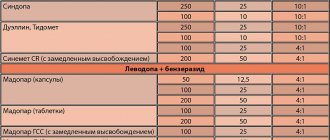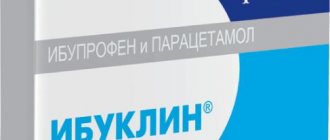Antigrippin
Antigrippin (paracetamol + ascorbic acid + chlorphenamine) is a combination drug for symptomatic pharmacotherapy of acute respiratory viral infections (ARVI). According to statistics from the World Health Organization, the latter account for up to 90% of all clinical cases of infectious diseases. Every year in our country tens of millions of people become victims of ARVI. Each specific case of the disease has its own specific features: for example, influenza viruses, adenoviruses and respiratory syncytial viruses attack the epithelium of the upper and lower respiratory tract, rhinoviruses attack the epithelium of the nasal cavity, parainfluenza viruses attack the larynx, and adenoviruses cause conjunctivitis. Such “invasion campaigns” occur as follows: infectious agents, having an affinity for the mucous membrane of the respiratory tract, invade epithelial cells, triggering the flywheel of a local inflammatory reaction. The resulting cell breakdown products “poison” the systemic bloodstream with toxins, as a result of which a painfully familiar picture with clinical claims develops: headaches and muscle pain, lethargy, weakness, fever, local reactions (cough, runny nose, sore throat and sore throat). There are many pitfalls in the treatment of ARVI, but the biggest problem here is the impossibility of prescribing pathophysiological therapy aimed at the cause of the disease. In this regard, practitioners have to be content with symptomatic treatment. Fortunately, today there is a whole arsenal of medicines for this, including non-steroidal anti-inflammatory drugs, anticongestants (relieving swelling of the mucous membranes), antitussives, bronchodilators, immunomodulators, etc. But the prescription of antibiotics for acute respiratory viral infections is not always advisable and is justified only in the case of an associated bacterial infection. Since many different viruses are responsible for the occurrence of ARVI, the optimal option for symptomatic treatment of this group of diseases should be considered the use of certain combination drugs that can cover the entire symptom complex of ARVI.
The non-steroidal anti-inflammatory drug paracetamol is one of the most common components of such drugs. Its antipyretic effect is realized through the suppression of the synthesis of prostaglandin inflammatory mediators in the central nervous system, which becomes possible due to the ability of the drug to inactivate cyclooxygenase. Paracetamol is distinguished from other NSAIDs by its safety in relation to the gastrointestinal tract: it blocks the synthesis of prostaglandins in the hypothalamic centers of thermoregulation and pain, without affecting other organs and tissues. In order to prevent nasal congestion, antihistamines, for example, chlorphenamine, are added to combined anti-influenza drugs: it eliminates allergy symptoms (sneezing, red eyes, lacrimation), and facilitates nasal breathing. Another “regular” of multi-symptomatic means of combating the manifestations of ARVI is vitamin C or ascorbic acid. It stimulates the production of the immune protein interferon, normalizes the processes of free radical oxidation of lipids, reduces the permeability of the vascular wall, and eliminates the deficiency in itself that has developed against the background of the disease. The drug antigrippin, which includes all of the above components, is today one of the most balanced anti-influenza complexes. It is available in the form of soluble tablets in a variety of flavors. The drug should be taken between meals, 1 tablet 2-3 times a day, dissolving them in a glass of warm water. The maximum daily dose should not exceed 3 tablets. The duration of use of antigrippin as part of self-medication is no more than 5 days (as an analgesic) and no more than 3 days (as an antipyretic). The drug does not contain sugar (with the exception of chamomile and honey-lemon flavors), so it can be used in patients suffering from diabetes.
Antigrippin pharmaceutical
Allergic reactions (skin rash), dyspeptic disorders, headache are possible.
In accordance with the components included.
The frequency of adverse reactions is classified according to the recommendations of the World Health Organization: very often (≥ 1/10), often (from ≥ 1/100 to < 1/10), infrequently (from ≥ 1/1000 to < 1/100), rarely (from ≥ 1/10000 to <1/1000), very rare (< 1/10000), frequency unknown (cannot be estimated from available data).
Acetylsalicylic acid
Blood and lymphatic system disorders:
uncommon - hemorrhagic syndrome (nosebleeds, bleeding gums, hemorrhagic rash), increased blood clotting time. These effects persist for 4-8 days from the moment the drug is stopped and should be taken into account when planning subsequent operations for patients.
Immune system disorders:
often - skin rash, very rarely - bronchospasm, Quincke's edema. Formation based on the hapten mechanism of the “aspirin” triad (a combination of bronchial asthma, recurrent polyposis of the nose and paranasal sinuses, and intolerance to acetylsalicylic acid and pyrazolone drugs).
Nervous system disorders
: infrequently - headache, dizziness, in some cases - decreased hearing acuity, ringing in the ears.
Gastrointestinal disorders:
often - nausea, vomiting, pain in the epigastric region, loss of appetite, rarely - diarrhea (diarrhea), gastrointestinal bleeding (vomiting like “coffee grounds”, black “tarry” stools); very rarely - increased activity of liver transaminases, in some cases - ulcer - perforation of the stomach.
Disorders of the liver and biliary tract:
very rarely - Reye's syndrome (encephalopathy and acute fatty liver with acute development of liver failure).
Metamizole sodium
Blood and lymphatic system disorders:
rarely - leukopenia; very rarely - agranulocytosis, including fatal cases and thrombocytopenia; frequency unknown - aplastic anemia, pancytopenia, including fatal cases. These reactions are immunological reactions in nature. They can occur even if the drug has been taken many times before without any complications.
Typical symptoms of agranulocytosis are lesions of the mucous membranes (cornea and pharynx, anorectal region and genital organs), sore throat, and fever. However, when antibiotics are used, these phenomena may be mild. Sometimes, but not always, there is a slight enlargement of the lymph nodes or spleen. The erythrocyte sedimentation rate increases significantly, the content of granulocytes is sharply reduced or they are not detected. As a rule, hemoglobin, red blood cells and platelets remain normal, but deviations may occur. Typical symptoms of thrombocytopenia are an increased tendency to bleeding and the appearance of petechiae on the skin and mucous membranes.
If there is an unexpected deterioration in the general condition, the fever does not subside, or new or painful ulcerations appear on the mucous membranes, especially in the mouth, nose or throat, treatment tactics involve immediate discontinuation of the drug without waiting for laboratory results.
If pancytopenia develops, the drug should be discontinued and a complete blood count should be monitored until its values return to normal (see “Special Instructions”).
Immune system disorders:
rarely - anaphylactic/anaphylactoid reactions; very rarely - analgesic bronchial asthma; frequency unknown - anaphylactic shock.
Metamizole sodium may cause anaphylactic or anaphylactoid reactions, which in very rare cases can be severe and life-threatening. They can occur even if metamizole sodium has been previously taken many times without any complications. Such drug reactions may occur immediately or several hours after taking metamizole sodium, usually within one hour.
In milder cases, they manifest themselves in the form of skin and mucous membrane symptoms (itching, burning, flushing, urticaria, swelling) or in the form of shortness of breath or complaints from the gastrointestinal tract.
In severe cases, these reactions develop into generalized urticaria, severe angioedema (especially involving the larynx), severe bronchospasm, cardiac arrhythmias, a sharp decrease in blood pressure (which is sometimes preceded by an increase in blood pressure) and the development of circulatory shock.
In persons with analgesic bronchial asthma syndrome and intolerance to analgesic drugs, these reactions manifest themselves in the form of attacks of bronchial asthma.
Cardiac disorders:
frequency unknown - Kounis syndrome (allergic coronary syndrome, manifested by clinical and laboratory signs of angina caused by inflammatory mediators).
Vascular disorders:
infrequently - isolated arterial hypotension.
After taking the drug, an isolated transient decrease in blood pressure is possible (possibly pharmacologically caused and not accompanied by other manifestations of anaphylactic/anaphylactoid reactions); in rare cases, the decrease in blood pressure can be very pronounced. During fever, a dose-dependent sharp decrease in blood pressure without other signs of a hypersensitivity reaction is also possible.
Skin and subcutaneous tissue disorders
: uncommon - fixed drug dermatitis; rarely - skin rash; frequency unknown - Stevens-Johnson syndrome, Lyell's syndrome (toxic epidermal necrolysis).
Renal and urinary tract disorders
: very rarely - renal dysfunction; frequency unknown - interstitial nephritis; In very rare cases, patients with impaired nocturnal function may experience an acute deterioration in renal function (acute renal failure), in some cases with oliguria, anuria or proteinuria.
General disorders
: Infrequently, urine may turn red due to the presence of a metabolite in the urine - rubazonic acid.
Diphenhydramine
Blood and lymphatic system disorders:
hemolytic anemia, thrombocytopenia, agranulocytosis.
Immune system disorders:
urticaria, photosensitivity, skin rash, itching, anaphylactic shock.
Metabolic and nutritional disorders:
sweating, chills.
Nervous system disorders
: dizziness, drowsiness, nervousness, insomnia, euphoria, general weakness, fatigue, sedative effect, decreased attention, headache, impaired coordination of movements, decreased psychomotor reaction speed, anxiety, increased excitability (especially in children), irritability, confusion, tremor , neuritis, convulsions, paresthesia.
Visual disorders:
visual impairment, diplopia.
Hearing and labyrinth disorders:
vertigo, acute labyrinthitis, tinnitus, can provoke an epileptiform attack.
Cardiac disorders:
palpitations, tachycardia, extrasystole.
Vascular disorders:
hypotension.
Disorders of the respiratory system, chest and mediastinal organs:
dryness of the mucous membrane of the mouth, nose, bronchi (increased sputum viscosity), tightness in the chest.
Gastrointestinal disorders:
dry mouth, short-term numbness of the oral mucosa. anorexia, diarrhea, constipation, nausea, epigastric discomfort, vomiting.
Renal and urinary tract disorders
: urinary disorders, urinary retention.
Genital and breast disorders
: early menstruation.
If any of the adverse reactions indicated in the instructions worsen, or you notice any other adverse reactions not listed in the instructions, tell your doctor.

